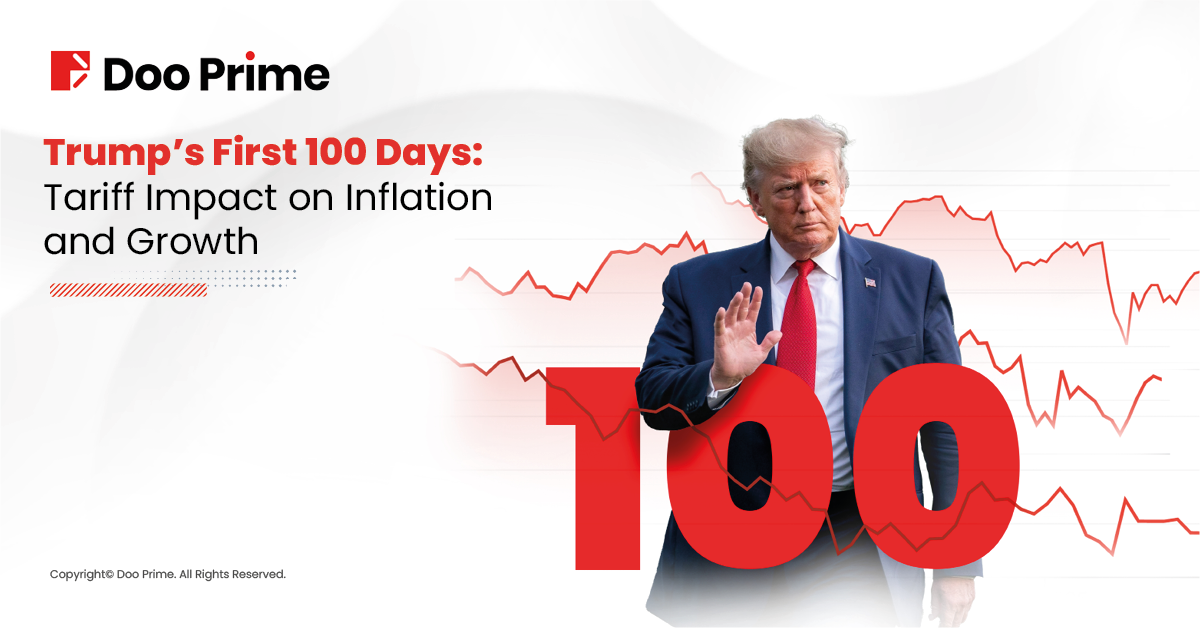
It’s been just over 100 days since Trump returned to the White House, and markets are already feeling the tremors.
From new tariffs and inflation concerns to shifts in business confidence and economic expectations, the early moves from the Trump administration are shaping the next phase of the U.S. economy.
In this article, we break down the real signals coming from the markets, not just the headlines, including the tariff impact on inflation, shifts in business confidence, and rising fears about unemployment.
Here’s what traders and investors need to watch next.
Tariff Impact on Inflation
One of the clearest signals in Trump’s first 100 days? Inflation expectations are sticking around at elevated levels.
Take a look at this chart from the University of Michigan:

After Trump’s April 2 tariff escalation, inflation expectations spiked sharply, touching the highest levels seen since early 2023. Even after a partial pause in tariffs announced on April 9, expectations remain elevated, suggesting that once inflation fears take hold, they don’t simply vanish overnight.
Key takeaway:
Even if the tariffs slow down, the damage to inflation sentiment has already been done. Consumers and businesses alike are preparing for higher prices.
Confidence is Slipping Among Business Leaders
It’s not just the tariff impact on inflation or consumers adjusting, CEOs are feeling the heat too.
Check out the CEO Confidence Index, tracking how business leaders view the economy one year ahead:

Notice the recent sharp drop toward 5, one of the lowest readings in the last decade.
This matters because CEOs drive decisions about hiring, investment, and expansion. When their confidence slips, it often signals slower economic growth on the horizon.
Why does this matter for traders?
Lower CEO confidence often translates into cautious earnings guidance and weaker capital spending. This, in turn, can lead to softer hiring and put pressure on the stock market, especially in sectors tied to business investment.
Fear of Rising Unemployment is Growing
Another warning light flashing: more Americans expect unemployment to rise over the next 12 months.

Since early 2024, expectations for rising unemployment have soared, reaching levels not seen since the Great Financial Crisis of 2008–2009.
Historically, such spikes tend to precede periods of economic stress, sometimes recessions, sometimes sharp slowdowns.
Connecting the dots:
- Tariff impact on inflation fears.
- Business confidence is dropping.
- And workers are bracing for job losses.
That’s not exactly the recipe for a smooth expansion.
Tariff Impact on Inflation: What’s Driving These Trends?
The answer is simple but important: policy uncertainty.
Trump’s early moves, especially around tariffs and trade, have reignited old market fears:
- Higher tariffs = higher input costs for businesses = passed onto consumers = inflation.
- Trade wars = lower corporate margins + slower global growth.
- Regulatory rollbacks and aggressive tax proposals create short-term excitement, but medium-term doubt about stability.
The market doesn’t mind change; it just hates uncertainty.
And Trump’s first 100 days have added plenty of uncertainty to the mix.
Sectors to Watch
In this environment, not all sectors are equally exposed. Based on current signals:
- Industrials and Materials: Highly sensitive to tariffs and global growth trends. Expect volatility.
- Tech: Still strong on fundamentals, but watch for impact if broader recession fears grow.
- Consumer Staples: Historically outperform during slowdowns as investors seek safety.
- Financials: Sensitive to Fed policy. If growth expectations fall, so do rate hike bets and so does the sector.
Remember, sectors don’t move in a vacuum. They follow macro forces and right now, those forces are shifting.
What to Expect Next?
Trump’s first 100 days have added fuel to already simmering concerns about inflation, trade instability, and future economic growth.
The charts tell a simple story:
- Tariff impact on inflation expectations are stubbornly high.
- Business leaders are growing cautious.
- Workers expect tougher times ahead.
Whether these fears spiral into an actual recession will depend on the next set of moves by Trump, by the Fed, and by consumers themselves.
For traders and investors, the roadmap is clear:
- Stay flexible.
- Watch the data, not just the noise.
- And remember: when uncertainty rises, opportunity rises too but so does risk.
“Markets are made on fear and greed. The trick is not to get caught at the extremes.”
Risk Disclosure
Securities, Futures, CFDs and other financial products involve high risks due to the fluctuation in the value and prices of the underlying financial instruments. Due to the adverse and unpredictable market movements, large losses exceeding your initial investment could incur within a short period of time.
Please make sure you fully understand the risks of trading with the respective financial instrument before engaging in any transactions with us. You should seek independent professional advice if you do not understand the risks explained herein.
Disclaimer
This information contained in this blog is for general reference only and is not intended as investment advice, a recommendation, an offer, or an invitation to buy or sell any financial instruments. It does not consider any specific recipient’s investment objectives or financial situation. Past performance references are not reliable indicators of future performance. Doo Prime and its affiliates make no representations or warranties about the accuracy or completeness of this information and accept no liability for any losses or damages resulting from its use or from any investments made based on it.
The above information should not be used or considered as the basis for any trading decisions or as an invitation to engage in any transaction. Doo Prime does not guarantee the accuracy or completeness of this report and assumes no responsibility for any losses resulting from the use of this report. Do not rely on this report to replace your independent judgment. The market is risky, and investments should be made with caution.



